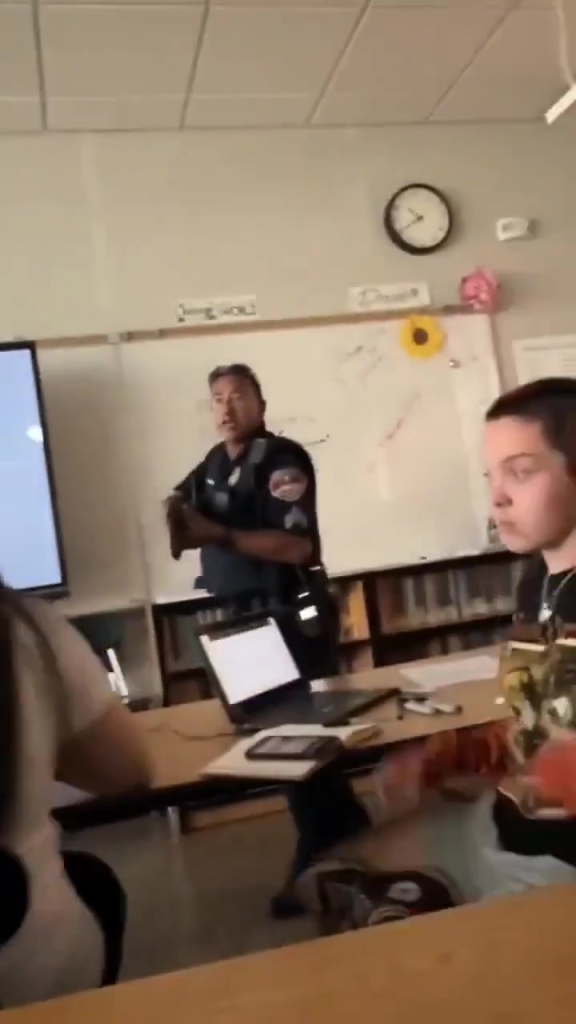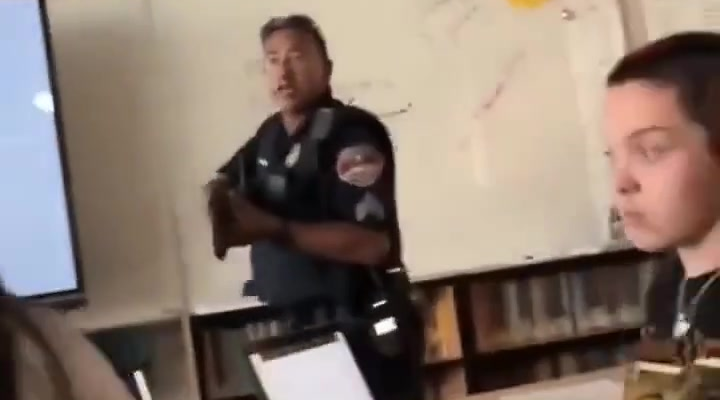Introduction
Schools are meant to be safe environments where students can learn, grow, and prepare for the future. However, recent events across the country have raised serious questions about just how secure these spaces are. One such incident, recorded on a student’s phone and shared widely online, involved a police officer drawing his firearm on a teenager who was suspected of carrying a weapon on school grounds.
The video quickly spread across social media platforms, attracting millions of views and igniting conversations far beyond the walls of the school itself. The event did not result in any physical harm, but the image of a uniformed officer aiming a gun at a high school student in a crowded hallway has left parents, educators, and community leaders grappling with complex questions.
This article will examine the confrontation itself, the immediate aftermath, the diverse community reactions, and the broader implications for school safety policies nationwide. Additionally, we will explore what this event reveals about the larger challenges schools face in balancing security, student rights, and mental health needs.
The Confrontation: What Happened
The now-viral video, filmed by another student, shows a tense exchange unfolding in a school hallway. The school resource officer, acting on reports that a student might be armed, can be seen pointing his service weapon at the teenager while issuing firm commands.
The student, visibly unsettled, resists the officer’s instructions. Instead of immediately complying, he questions why he should get on the ground, asking, “What do you want me on the ground for?” His peers, clearly frightened, either scatter in different directions or record the unfolding scene.
While the footage captures only part of the incident, official reports confirm that administrators had received information suggesting the student may have had a firearm. In response, the officer chose to draw his weapon as a precautionary measure.
The Immediate Aftermath
Fortunately, the situation ended without gunfire. The officer successfully detained the student, and a firearm was recovered during the search. The teenager, identified as a 16-year-old male, was taken into custody. He now faces legal charges related to unlawful possession of a firearm on school grounds.
School officials acted swiftly to follow established safety protocols. These included:
- Securing classrooms and keeping students inside.
- Notifying law enforcement immediately.
- Alerting parents through the school’s emergency communication system.
- Making counseling and emotional support services available for those affected.
While many praised the rapid and orderly response, others expressed deep concern about the long-term impact of such a traumatic event on young students who witnessed it firsthand.
Parents’ and Students’ Perspectives
The incident triggered a wave of strong emotions across the community. Parents were torn between relief and alarm. Some argued that the officer’s actions potentially saved lives, while others were horrified by the thought of a gun being pointed at their child’s classmate inside a learning environment.
One parent shared:
“I am thankful that nothing tragic happened, but it is deeply unsettling to know that my child’s school is a place where weapons are found and officers feel the need to draw their guns.”
Students also expressed mixed feelings. While some said they felt reassured by the officer’s willingness to act quickly, others admitted they were left shaken by the sight of an armed confrontation taking place only steps away from their classrooms.
Community and Educator Reactions
Educators and local leaders weighed in on the situation with a wide range of opinions.
- Supporters of armed school officers emphasized that rapid responses are crucial in situations where lives may be at risk. They argued that without immediate and decisive action, the possibility of harm could increase.
- Critics of the approach contended that pointing a firearm at a student in a crowded hallway may have escalated the danger. They pointed out that a single misstep, misunderstanding, or accidental discharge could have had devastating consequences.
- Mental health advocates highlighted the importance of preventative measures, noting that schools must not only respond to potential threats but also invest in counseling, mentorship, and early intervention programs to prevent violence before it occurs.
The Broader Debate: Police Presence in Schools
The confrontation reignited a longstanding debate about the role of police officers in educational settings.
Arguments in Favor of School Resource Officers (SROs):
- Deterrence: Supporters claim that the presence of armed officers deters potential violence.
- Rapid Response: In emergencies, having an officer on-site reduces response times dramatically.
- Relationship Building: Some programs focus on officers serving as mentors, not just enforcers.
Arguments Against SROs:
- Escalation of Conflict: Critics argue that introducing weapons into schools heightens risks.
- Disproportionate Impact: Studies suggest that students of color are more likely to face disciplinary action or criminal charges when police are stationed in schools.
- Psychological Impact: The presence of armed officers can contribute to a climate of fear rather than safety.
This dual perspective reflects the ongoing struggle to balance immediate security with long-term educational goals.
A National Trend of Rising Firearms in Schools
Beyond the debate over policing, experts point to a troubling trend: the increasing number of firearms discovered on school campuses. Recent data suggests that more schools across the nation are reporting incidents where weapons are brought onto property, often by students themselves.
Contributing factors include:
- Easier access to firearms in households.
- Broader societal violence spilling into schools.
- Mental health challenges among youth.
- Influence of social media and viral challenges.
Experts stress that prevention must go beyond policing. Addressing root causes—such as strengthening mental health resources, limiting access to firearms, and fostering positive school climates—is essential.
The Psychological Impact on Students
One of the most concerning aspects of the incident is the long-term effect it may have on students who witnessed it. Young people exposed to moments of high tension, especially those involving firearms, often experience:
- Heightened anxiety about attending school.
- Difficulty concentrating in class.
- Distrust of authority figures, including teachers and officers.
- Lingering trauma that may require professional counseling.
Schools are now being called upon to not only maintain physical safety but also safeguard emotional and psychological well-being.

What Happens Next
The student involved is expected to appear in juvenile court in the coming weeks. Depending on the outcome, he may face penalties ranging from probation and mandated counseling to more serious legal consequences.
Meanwhile, school administrators have pledged a comprehensive review of current safety protocols. They are working with local law enforcement to evaluate whether additional measures—such as increased surveillance, revised training for staff, or alternative de-escalation strategies—are necessary.
Broader Lessons for School Safety
This incident, while unique in its details, is part of a much larger conversation unfolding nationwide. Key takeaways include:
- Preparedness is essential: Schools must have clear safety plans and ensure staff and students know how to respond.
- Prevention should be prioritized: Identifying warning signs and providing early intervention can stop dangerous situations before they escalate.
- Balance is necessary: While security is vital, schools must remain welcoming environments where students feel supported, not policed.
- Community voices matter: Parents, students, and educators must be part of the decision-making process when it comes to security measures.
Conclusion
The image of a police officer pointing a firearm at a teenager in a school hallway is one that has sparked both fear and relief. For some, it demonstrates decisive action that prevented tragedy. For others, it raises troubling questions about escalation, student safety, and the role of policing in education.
As the legal process continues and the school reviews its safety policies, the larger debate will not disappear. Across the nation, communities are asking the same difficult questions: How do we keep schools safe without compromising the emotional health of students? How do we prevent violence while preserving the spirit of education? And most importantly, how can we ensure that every child feels secure enough to learn and thrive?
This event serves as a reminder that school safety is not a single issue but a complex challenge requiring collaboration, compassion, and long-term solutions.



